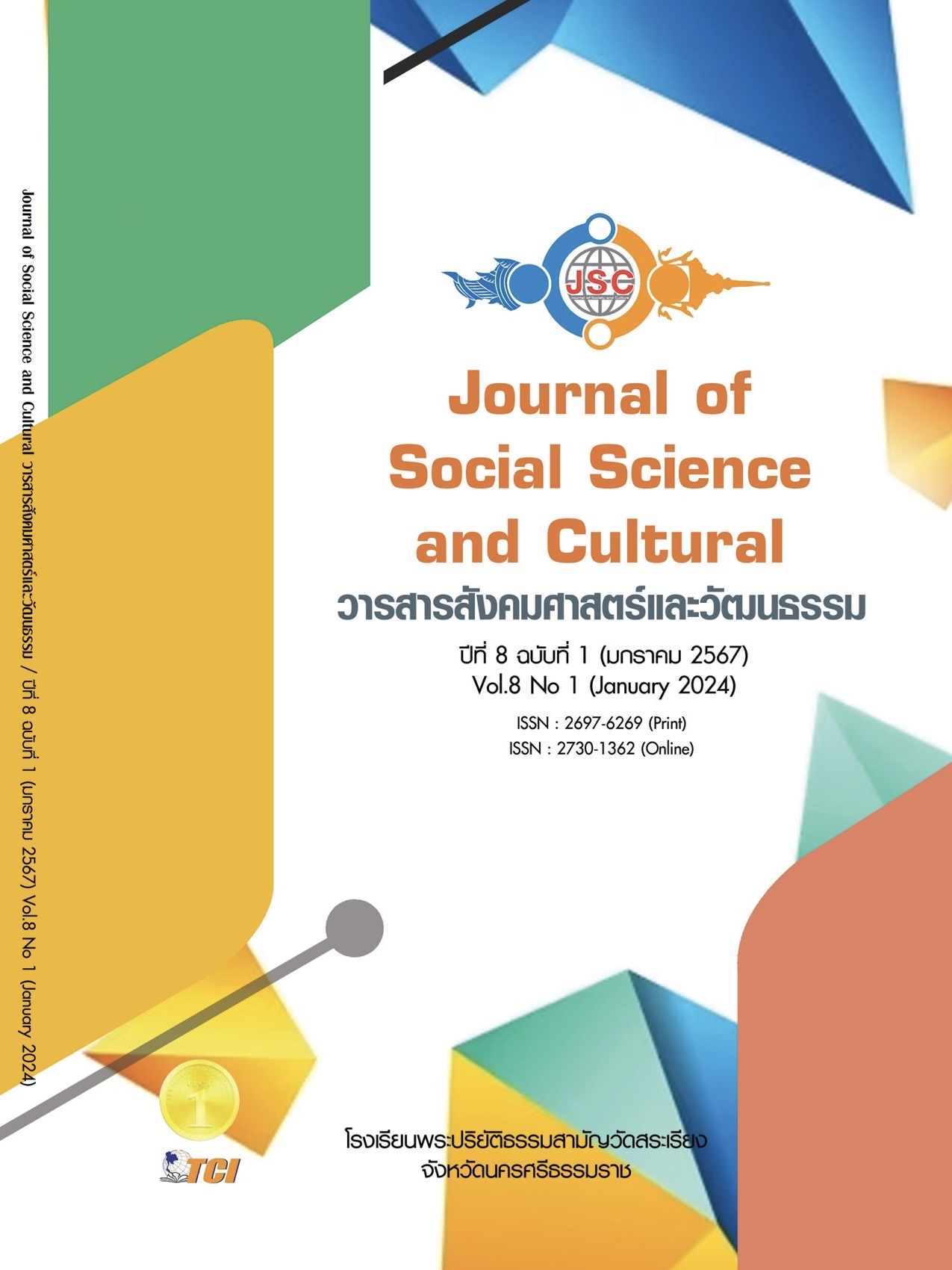THE DEVELOPMENT OF SCHOOL ADMINISTRATION STRATEGY BASED ON THE CONCEPT OF NO CHILD LEFT BEHIND BY SCHOOLS UNDER THE SECONDARY EDUCATIONAL SERVICE AREA OFFICE BURIRAM
Main Article Content
Abstract
This research article aims to 1) study and confirm factors and indicators based on the concept of no child left behind. 2) create and develop strategies based on the concept of no child left behind. and 3) evaluate school administration strategy based on the concept of no child left behind by schools under the secondary education service area office Buriram. This research is mixed-method research. By random sampling calculated from Comrey & A. Lee.formula, there were a total of 502 people from a population consisting of school administrators and teachers. The research instruments were questionnaires, interviews, and strategy assessment forms. The statistics used in the research include percentage, mean, standard deviation. and analysis of components and indicators. The research results found that: 1) Study results and confirmation Components and indicators have 4 factor is: 1.1) Strengthening safe spaces in educational institutions 3 indicators. 1.2) Reducing inequality to improve educational efficiency 4 indicators. 1.3) Classroom management and learning management design 3. Indicators and 1.4) In terms of administration and education policy, there are 4 indicators. The component weights are between .517-.998. The overall component measurement model has construct validity and is statistically significant. Chi-square = 42.492, df = 32, P Value = 0.1017, RMSEA = 0.020, CFI = 0.998, TLI. = 0.996, SRMR = 0.047 and structural confidence is between 0.445*- 0.996* 2) Results of strategy creation and development With the SWOT and TOWS Matrix Analysis process, 4 main strategies can be determined. S3) The overall results of the evaluation of school administration strategies based on the concept of leaving no child behind are appropriate at the highest level. There is a high level of possibility. and is useful at the highest level The strategy can be applied according to the context of the educational institution and disseminated further.
Article Details
References
ทรงศักดิ์ ภูสีอ่อน. (2561). การประยุกต์ใช้ SPSS วิเคราะห์ข้อมูลงานวิจัย. (พิมพ์ครั้งที่ 8). มหาสารคาม: ตักสิลาการพิมพ์.
บุญชม ศรีสะอาด. (2545). การวิจัยเบื้องต้น. (พิมพ์ครั้งที่ 7). กรุงเทพมหานคร: สุวีริยาสาสน.
ปะราลี อร่ามดวง. (2563). การพัฒนากลยุทธ์การบริหารวิชาการโรงเรียนมัธยมศึกษาตามแนวคิดการเสริมสร้างความไว้วางใจ. ใน ดุษฎีนิพนธ์ตามหลักสูตรครุศาสตร์ดุษฎีบัณฑิต สาขาวิชาการบริหารการศึกษา. คณะครุศาสตร์ จุฬาลงกรณ์มหาวิทยาลัย.
พฤทธิ์ ศิริบรรณพิทักษ์. (2552). การจัดการศึกษาเพื่อการพัฒนาที่ยั่งยืน : พื้นฐานการศึกษาด้านเศรษฐกิจ สังคม และสิ่งแวดล้อม. กรุงเทพมหานคร: โรงพิมพ์ไทยสัมพันธ์.
มูลนิธิสถาบันวิจัยเพื่อการพัฒนาประเทศไทย. (2556). การจัดทำยุทธศาสตร์การปฏิรูปการศึกษาขั้นพื้นฐานให้เกิดความรับผิดชอบ. กรุงเทพมหานคร: มูลนิธิสถาบันวิจัยเพื่อการพัฒนาประเทศไทย.
รณชัย สุขสมบูรณ์. (2562). การพัฒนาคุณภาพการศึกษาตามนโยบาย ไม่มีเด็กคนใดถูกทิ้งไว้ข้างหลัง สำนักงานเขตพื้นที่การศึกษามัธยมศึกษาเขต 32. บุรีรัมย์: สำนักงานเขตพื้นที่การศึกษามัธยมศึกษาเขต 32.
วิชญา ชินธนาชูกิจ. (2563). กลยุทธ์การพัฒนาการจัดการศึกษาเพื่อการมีงานทำ โรงเรียนการศึกษาสงเคราะห์สังกัดสำนักบริหารงานการศึกษาพิเศษ . ใน ดุษฎีนิพนธ์การศึกษาดุษฎีบัณฑิต สาขาวิชาการบริหารการศึกษา. มหาวิทยาลัยนเรศวร.
วิริยะ ฤาชัยพาณิชย์. (2559). ห้องเรียนแห่งอนาคต เปลี่ยนครูให้เป็นโค้ช. กรุงเทพมหานคร: บริษัท ซีเอ็ดยูเคชั่น จำกัด มหาชน.
วีรยศ เอกรัตน์. (2564). กลยุทธ์ของโรงเรียนมัธยมศึกษาเพื่อพัฒนาประสิทธิผลการสอนตามแนวคิดความเจริญงอกงามของนักเรียน. ใน ดุษฎีนิพนธ์ครุศาสตร์ดุษฎีบัณฑิต สาขาวิชาการบริหารการศึกษา. จุฬาลงกรณ์มหาวิทยาลัย.
สายถวิล แซ่ฮ่ำ. (2564). กลยุทธ์การบริหารวิชาการโรงเรียนมัธยมศึกษาตามแนวคิดความกล้าหาญอดทน: พลังของความใฝ่ฝันและความบากบั่นพากเพียร. ใน ดุษฎีนิพนธ์ครุศาสตร์ดุษฎีบัณฑิต สาขาวิชาการบริหารการศึกษา. จุฬาลงกรณ์มหาวิทยาลัย.
สำนักงานคณะกรรมการศึกษาแห่งชาติ. (2542). พระราชบัญญัติการศึกษาแห่งชาติ พ.ศ.2542. กรุงเทพมหานคร: สำนักงานคณะกรรมการศึกษาแห่งชาติ.
อานนท์ ธิติคุณากร. (2562). กลยุทธ์การบริหารวิชาการโรงเรียนมัธยมศึกษาตามแนวคิดการพัฒนาทักษะสำหรับเศรษฐกิจสีเขียว. ใน ดุษฎีนิพนธ์ครุศาสตร์ดุษฎีบัณฑิต สาขาวิชาการบริหารการศึกษา. จุฬาลงกรณ์มหาวิทยาลัย.
อิฏฐิรา ทรงกิติพิศาล. (2563). กลยุทธ์การบริหารวิชาการโรงเรียนมัธยมศึกษาตามแนวคิดสมรรถนะภาวะผู้นำเชิงผู้ประกอบการ. ใน ดุษฎีนิพนธ์ครุศาสตร์ดุษฎีบัณฑิต สาขาวิชาการบริหารการศึกษา. จุฬาลงกรณ์มหาวิทยาลัย.
Bush, G. W. (2002). No Child Left Behind Act of 2001 Leadership and performance. beyond expectations. New York: Free Press.
Comrey, A. L. & Lee, H. B. (1992). A First Course in Factor Analysis. (2nd ed.). Hillsdale, New Jersey: Lawrence Erlbaum.
Gouveia, G. (2015). Philosophy and No child left behind: an epistemological analysis of the effects of educational policy on knowledge development. Doctor of Philosophy thesis: University of Iowa.
Hess, F. M. & Finn, C. E. (2004). Leaving No Child Behind: Options for Kids in Failing Schools. New Yok: Palgrave Macmillan.
Owen, J. M. & Rogers, P. J. (1999). Program Evaluation: From and Approaches. London: Sage.


